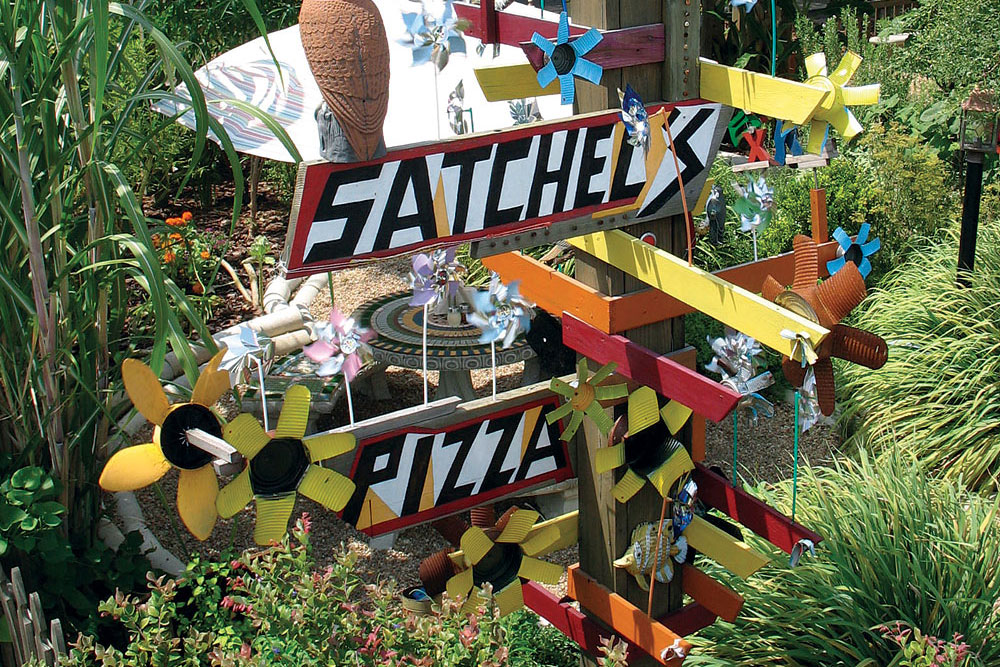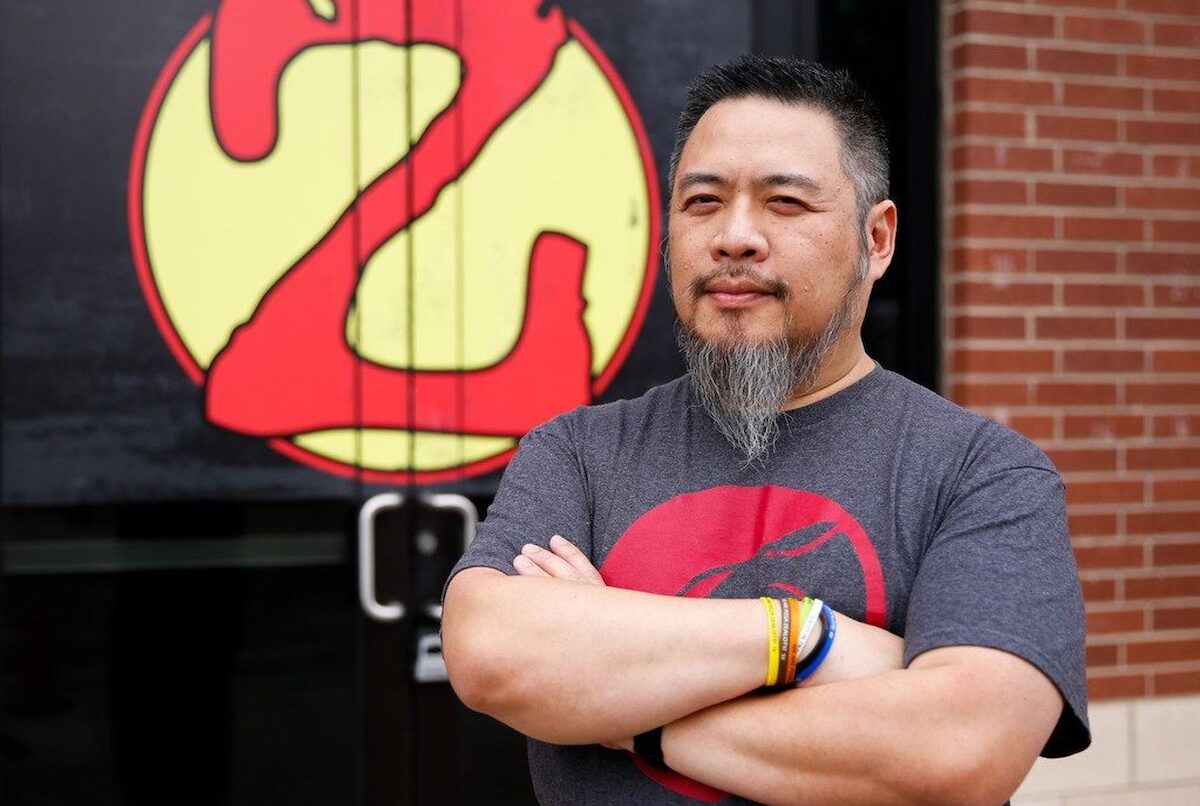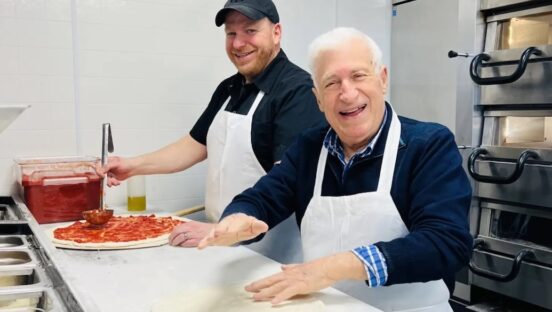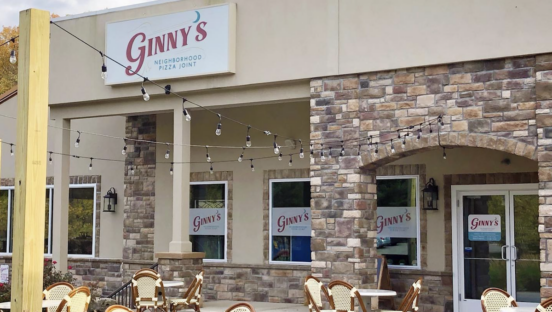Common sense should have told Satchel Raye that his concept for a pizzeria would never fly. The location—tucked away in a largely industrial, off-the-beaten-path section of northeast Gainesville, Florida—leaves much to be desired. His labor costs would give most restaurateurs the heebie-jeebies. And then there’s all that junk—ribbons of junk that dangle from the ceiling, a junked Ford Falcon van with four flat tires parked out in front, a graveyard of junked toys and appliances in the back, even a decorative fountain built entirely out of, you guessed it, junk.
All that’s missing, it seems, is an aggressive, slavering mongrel patrolling the lot, baring its fangs and snarling at passersby. But if it’s true, as the old cliche goes, that one man’s trash is another man’s treasure, Raye, who’s also an accomplished artist and sculptor, has been mining gold for nearly 10 years. Satchel’s Pizza (satchelspizza.com) hasn’t merely survived since he founded it in 2003; it has achieved near-legendary status among locals, University of Florida students and tourists alike, and not just for its offbeat decor and ambience. When Raye isn’t transforming found materials—such as lost glasses and cameras, bicycle wheels, Happy Meal toys and garden hoses—into decorative mobiles, sculptures and displays, he and his pizza makers are creating individual works of edible art in Satchel’s squeaky-clean kitchen. Baked to artisanal perfection with a crispy, buttery crust and a dark-brown bottom, arrayed with colorful toppings ranging from artichoke hearts to zucchini, the pizzas at Satchel’s are the No. 1 draw, and customers may wait up to an hour and a half to get a bite. Some get grumpy and leave, of course, but most know the pizza is worth the wait.
“We’re just busy,” Raye says, with an unapologetic shrug. “One of the bumper stickers we give away says, ‘Sorry I’m late, I was at Satchel’s.’ When you come here, you’ll be here for a while because we’re busy, and making good pizza takes time. But there’s a lot to do and plenty to look at while you’re waiting.”
The Stats: Satchel’s Pizza |
|
Headquarters: Gainesville, Florida Owner: Satchel Raye Total Units: 1 Year Started: 2003 Dine-in, carryout Number of employees: 50 Oven: Two Baker’s Pride deck ovens |
An Unusual Business Model
Raye is either the Fred Sanford of pizza or the Renoir of rubbish—take your pick. What he’s not, he’s the first to admit, is a money-hungry businessman with a watchful eye on the bottom line. Nearly 50% of Satchel’s annual revenue goes to labor costs, covering the restaurant’s 50 employees. “We pay them a living wage and offer retirement accounts, health benefits and paid vacation,” Raye says. “As a result, we get good people to stay around. I don’t want to be training people all the time. I’d rather give them a $1 raise because they work hard and know what they’re doing. Good employees make a restaurant run better, and it frees me up to do whatever I want to do.”
Raye sees restaurant work as a career, not a temporary job on the way to a better future. In fact, a number of Satchel’s staff members have worked there for more than nine years. Employees start out at $8 per hour and may get bumped up to $9 within a few weeks and, before long, $10 per hour. All tips are pooled together and split according to a formula among the entire staff. Raye even hands out bonus checks based on profits twice a year. And the restaurant closes on Sundays and Mondays, giving everyone two days off every week.
As if that isn’t peculiar enough, Raye runs a cash-only business. Customers who try to pay with a credit card are directed to an in-store ATM, and every $1.50 transaction fee goes to charity. Satchel’s also awards $500 grants each quarter to various local schools and nonprofit organizations.
Raye admits that his business model is unusual, to say the least. “I never went to business school,” he says, with a hint of pride. “I don’t know what the profit margin should be. We run close to 30% in food costs, 50% in labor costs and another 10% in operating expenses. You’re hoping for 10% left over in the end. If you do enough business, there’s still money there. But I’m more interested in paying people a living wage than in making more money for myself. I don’t need a Ferrari.”
An Instinct for Marketing
Fortunately, Raye, a Gainesville native who is married with two children, inherited his house from his grandparents and owns the Satchel’s property outright. And making a fortune has never been a high priority for him. In his 20s, he gave up his worldly belongings for a while to live as a homeless person in Atlanta, just to see how true poverty felt. He lived contentedly in that battered, sky-blue Ford Falcon off and on for years while washing dishes, making subs and slinging dough at restaurants, including Leonardo’s by the Slice in Gainesville, Gubbio’s and Santioni’s in Jacksonville, and Fellini’s in Atlanta. Only in 2003 did he finally decide to take the plunge and start his own pizzeria. “We did $196 on that first day,” he recalls. “It was a Friday night with two tables at dinner. I would take the order, go make the salad, come back with the salad, go back and make the pizza and come back again. Now, on a Friday night, we have about 21 employees with 300 customers coming through and an hour-and-a-half wait.”
Raye may lack the cutthroat instinct of a hard-nosed business mogul, but, when it comes to marketing his pizzeria, he’s a natural. He dismisses conventional wisdom about the importance of a restaurant’s location. “They say it’s location, location, location,” he says. “We’re in an industrial park on the east side of town. The university and all of the growth are on the west side of town. Our location is not ideal, but we have good products and good service, and people still find us. So I don’t think location is all that.”
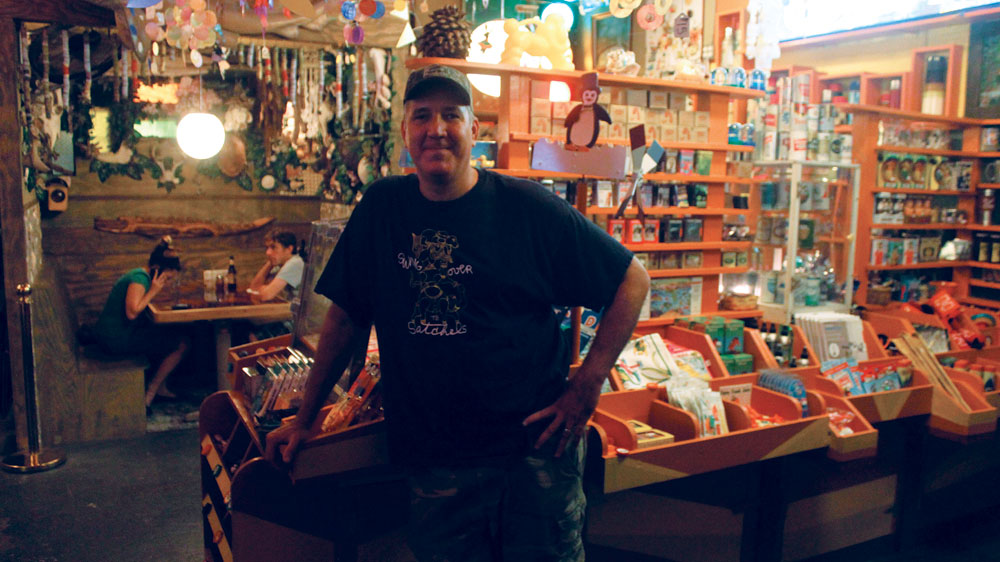 |
|
With two playgrounds, Satchel’s is a veritable wonderland of kid-friendly second-hand toys (top). Raye takes a breather in the Lightnin’ Salvage gift shop. |
Some customers may find Raye’s restaurant just by following the numerous cars bearing Satchel’s bumper stickers. Raye estimates that he has given away at least 50,000 over the years, one with every meal. “You eat here, you get a free bumper sticker,” he says. “We’ve got a lot of different slogans—‘Satchel’s Is for Lovers,’ ‘If Lost, Return to Satchel’s.’ We’re always trying to think of something cute that can be easily read from another car.”
Meanwhile, a souvenir shop, Lightnin’ Salvage, which adjoins the pizzeria, peddles more Satchel’s-branded merchandise, from T-shirts, hats and coozies to bandanas, headbands, pens, keychains and coin purses. Raye personally designs many of the products, and his employees often contribute as well. “It’s advertising and branding at the same time,” he says.
Not all of the items in Lightnin’ Salvage bear the Satchel’s logo, but they’re all kitschy, from the dancing hula girls and dashboard Jesuses to vintage-looking scratch-and-sniffs, “bacon wallets” and zombie bobbleheads.
Raye also targets families by providing a kid-friendly environment, complete with playgrounds, a treehouse in the rear corner of the lot, and even a bocce court next to the greenhouse (yes, there’s a greenhouse, too, filled with exotic plants). “When my wife and I would go out to eat with our one-year-old, we were told, ‘He can’t crawl around here.’ Well, he’s one year old; what else is he going to do? Should I take him to McDonald’s? Here, your kids can play while you’re eating. We even put a little play kitchen in the restaurant—it has toys they’ve never seen before, so they’re excited. You’re over there eating, and you can see your kid playing in the corner; he’s happy, everybody’s happy. It seems so obvious, but there’s not a lot of restaurants catering to kids.
“There’s always a risk involved,” he acknowledges. “A kid can get hurt. A lot of people would be scared to death of being sued. But we have great customers, and we don’t have any problems like that. We expect parents to watch their kids, and they do. This is what the parents want, and this is what we give them.”
-Satchel Raye
The Art of Pizza Making
Satchel’s feels like a wonderland to adults, too, with so much to see, hear, taste and smell that it can’t be fully experienced in a single visit. Original artwork adorns the walls, and live music often plays in the patio lounge area next to Lightnin’ Salvage. Guests of all ages can enjoy storytelling nights, reggae dances, ukelele events, pinecone contests and coloring book competitions.
Even the menus entertain and enlighten; each one features a unique design and a “story”—usually penned by Raye himself—printed on the back. In an engaging and down-to-earth style, Raye tells tales of his colorful past, shares insider secrets about the restaurant and promotes his favorite charities.
And then there’s the food itself. Satchel’s menu focuses on pizza—customers can build their own pizza from a smorgasbord of 30-plus toppings or opt for a pesto pie or ricotta-based white pie with any three toppings. Beyond that, they’ve got only a few other choices—the Major (featuring pepperoni, mushrooms, sausage, green peppers, onions and black olives), the Mama (with the customer’s choice of four toppings), a specialty pie with a crust made of millet and flax, and the three-topping Deep Dish.
“I do a lot of mandalas—symmetrical designs that radiate from the center outwards—in my work as an artist,” Raye says. “So, when I make a pizza, it’s like making art to me. I like to have different colors going on—pepperoni, ground beef, zucchini and carrots are some of my favorites. I teach my pizza makers to distribute the toppings evenly on the pizza and to get a nice, dark-brown bottom for a crispy effect.”
Customers rave about the calzones, too. Popular choices include the Hot Rope, made with spicy Italian sausage, green peppers, onions, ricotta and mozzarella; the Steak and Cheese, featuring thinly sliced ribeye steak sautéed with onions and smothered in mozzarella; and the PB&J, loaded with pepperoni, beef and jalapeño peppers as well as ricotta and mozzarella.
After the Fire
Along with its phenomenal success, Satchel’s has faced its share of tribulations. When a fire gutted the kitchen in February, the restaurant shut down for several months, leaving the staff without regular paychecks. Within two days of the blaze, Raye launched a fundraiser on Indiegogo.com, a crowdfunding site, to help his employees pay their bills during the downtime. In what was surely a powerful testament to Satchel’s popularity in the community, the fundraiser quickly met, then exceeded, Raye’s goal. “We wanted to raise $20,000 over two weeks,” Raye recalls. “We ended up getting $20,000 in 24 hours. You’d hit ‘refresh,’ and there’d be another hundred bucks or two hundred bucks. By the end of the two-week period, we’d raised more than $37,000 for the employees.”
When Satchel’s reopened in the summer, all but two of Raye’s staff members returned to their jobs. “It was scary to go from having a thriving business with 50 employees to having no income at all, and insurance didn’t cover the loss of business,” he says. “It was totally devastating, but it was really encouraging to see the community pitch in to help our employees. They all wanted us to reopen—everybody was behind us.”
Some in Gainesville wouldn’t mind seeing another Satchel’s open in the area, but Raye says that’s out of the question. “I don’t want to open another location, and I don’t want to franchise. I just want to have one place that’s really good.”
He’d rather spend his free time working on his art or playing with his kids than fretting over account ledgers and haggling with distributors. “I do enjoy making Satchel’s bigger and better and taking it up a notch,” he says. “I like that we’re so busy. I like that people have a good time here. But I could have just three employees and a few tables, and I’d be fine with that, too. I like what I do. I’m just a happy guy.”



